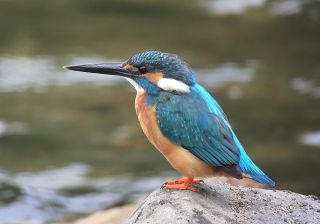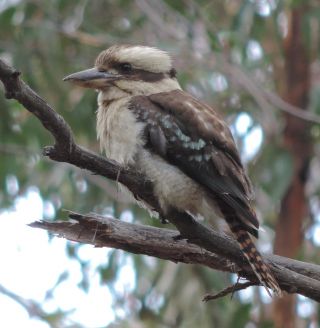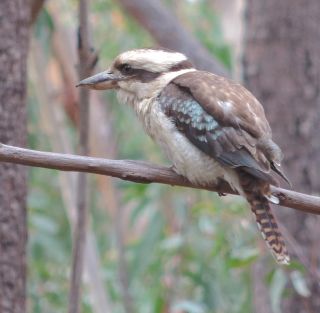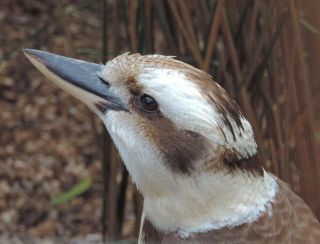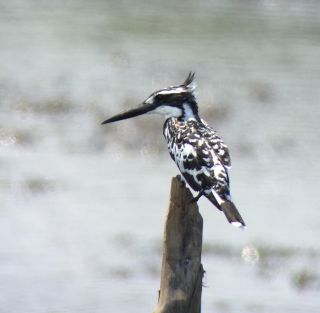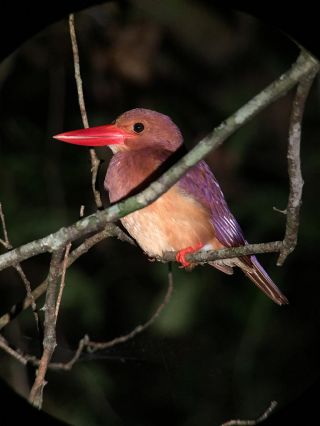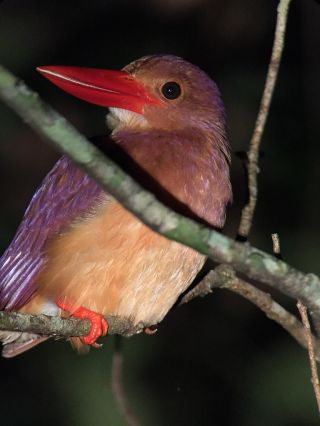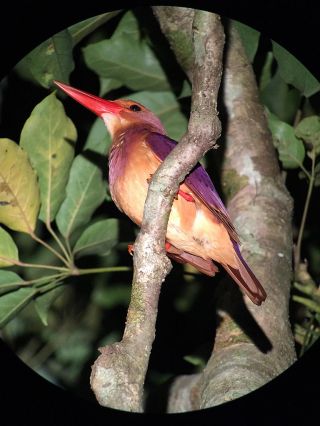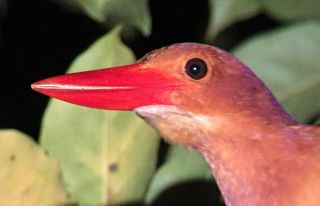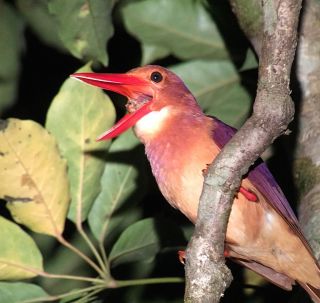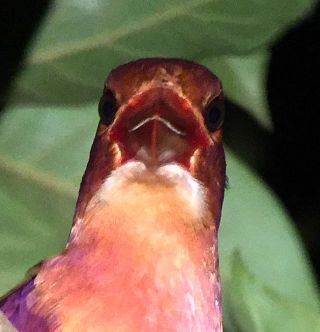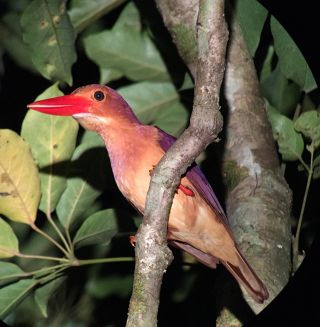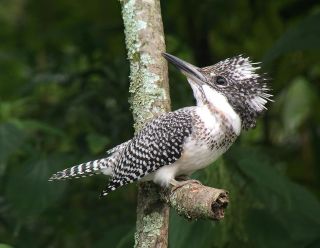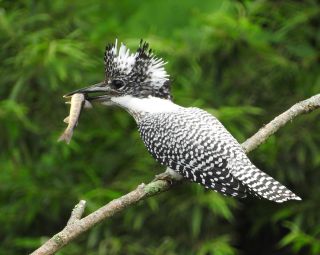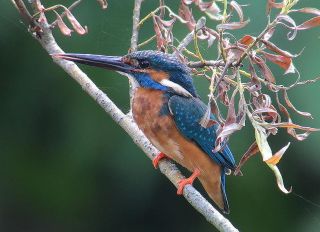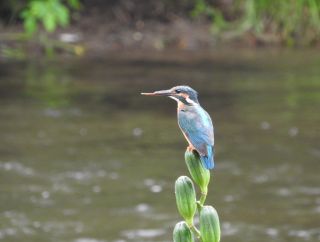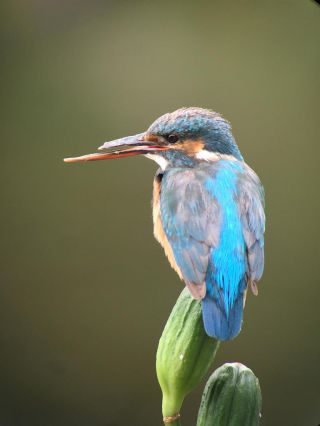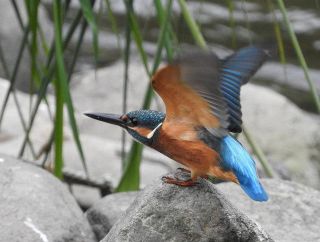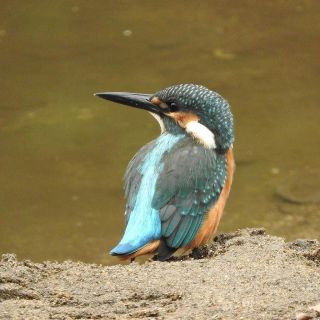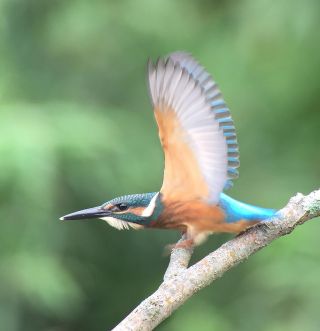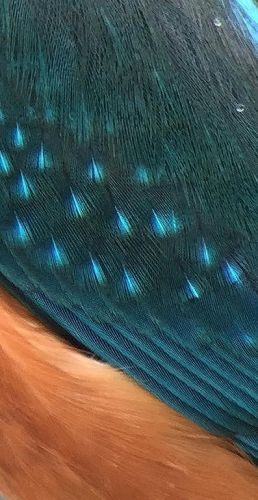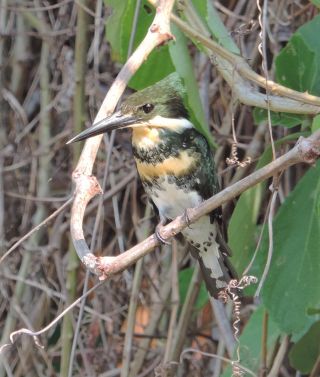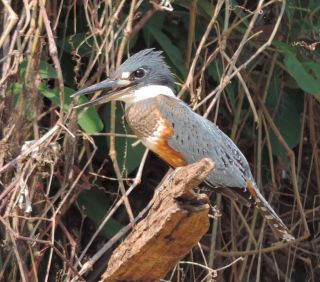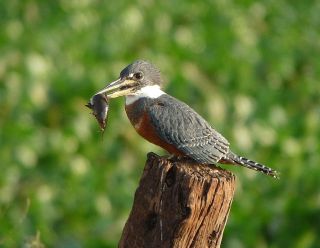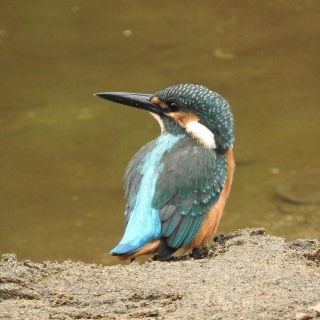Common Kingfisher © Mark Brazil
Halcyon Days
By Mark Brazil | Aug 31, 2016
The hunter and the hunted play out the ancient pattern of life all around us, evoking the nightmare scenarios of science fiction thrillers. You just need to know where to look.
Pairs of Autumn Darter dragonflies drift lazily past my window in their tandem, pre-mating flights. Day by day during August their numbers become more noticeable until finally they become abundant. There are dozens of them now, everywhere; they are lined up along fences, rails, branches and walls, aligned like squadrons of aircraft beside a runway awaiting permission for take-off. Many of those already in flight are distracted by procreation, and in their languid tandem state adrift on an updraft breeze, they are unaware of the dashing form of a Northern Hobby, a power-packed falcon, swooping in from behind them. This snatch and grab hunter jinks only momentarily in flight, lashes out with a foot to take another dragonfly in mid air.
Nearby the hobby has four youngsters yammering for food. They too are on the wing chasing dragonflies, but they have yet to hone their skills and like most young birds at this stage of growth they prefer to beg and scrounge a free meal whenever they can. Their demonstrative high-pitched calling and dashing flights above the trees that fringe the nearby railway line are a daily delight, and seem so conspicuous, yet even as the hobbies swoop and dash about noisily overhead they seem to go unnoticed by local residents. When such blatant performers are overlooked it is not surprising then that more secretive hunters are entirely missed.
While the falcons are adept at snatching their prey from the air, other predatory birds focus their attention on seizing their food from the ground or from water, and few can compare with the gem-like gorgeousness of the kings of fishers as they hunt.
A trio of kingfishers calls Japan home and each is startling in its beauty. One, the Ruddy Kingfisher, or Akashobin, favours humid regions and is most at home in the broadleaved evergreen forests of the south; another, the largest, the Crested Kingfisher or Yamasemi, prefers fast flowing mountain streams and rivers; and the third, the smallest of the three, the Common Kingfisher or Kawasemi can be found from Hokkaido to Okinawa at a wide range of waterways, including streams, rivers, lakes and reservoirs, and even, in winter, shorelines and harbours.
Kingfishers are not merely dazzling and gem-like, they also provide naturalists with a splendid example of adaptive radiation. They range in size from the diminutive African Dwarf Kingfisher at just 10 cm long, to the enormous, 43 cm long Laughing Kookaburra of Australia, and they range in habitats from arid grasslands and dense forests to open water.
The unique fish-eating habit with which we associate the kingfishers, belie the fact that as a group they feed in a wide range of ways. Some of those in Southeast Asia and Africa occur in lush, humid forested habitats wherein they search for prey from a high vantage point before swooping down to the ground to snatch an insect or other invertebrate or a small vertebrate from the forest floor; others meanwhile splash recklessly into woodland ponds. At one extreme there are kingfishers that occur exclusively in dry land habitats and live as insectivores, whereas others feed exclusively from the water, and one, the Pied Kingfisher will even fish at sea. Many of the kingfishers hover briefly before splashing down onto prey, but the Pied Kingfisher of Africa, South and Southeast Asia has taken hovering to perfection and seems to favour aerial fluttering to hunting from a fixed perch.
Kingfishers belong to a group known as Coraciiform birds (this group also includes rollers, ground rollers, hornbills, and bee-eaters), but of these it is the kingfishers that are the best known in the northern hemisphere. Coraciiform species, though diverse in form, size and structure, share a range of features in common; they are, for example, carnivorous eating small fish, amphibians, reptiles, small mammals and insects. They are also cavity nesters, digging their nest holes in banks or rotten trees, and strangely they share an unusual arrangement of their toes. Whereas most birds have three separate forward toes and one hind toe, allowing them to perch easily on branches, in these Coraciiform birds the anterior three toes are conjoined for part of their length, in an odd condition known as syndactly. Look closely at any photograph of a kingfisher and you will notice that the longer forward toe is fused to the adjacent toe. It is said that such fused toes are helpful when excavating a nesting tunnel.
Japan’s Ruddy Kingfisher is a spectacular creature. It can be secretive and elusive in its forest habitat, but its haunting, rippling call – a long descending whistle – rings out repeatedly at daybreak through the humid forests of Okinawa and Amami Oshima and northwards into Honshu. Elusive and nervous during daylight, it rarely stays still long enough to show off its gorgeous colouring, but it can sometimes be found roosting quietly at night, when it can be watched at leisure. Then, its burnt-orange plumage can be seen to have a strong sheen of iridescent violet shimmering across its crown, breast and wings. Its syndactylous feet are a bright orange, and its enormous beak is of such a redness that only resurrecting the term sealing-wax red will do to describe it.
This forest hunter is more likely to take a lizard, a frog or an enormous beetle than it is to consume a fish. But what is it to do with all of those prey items’ indigestible hard parts, the bones, scales, toenails and elytra? Like its close relatives, and like owls and raptors, the Ruddy Kingfisher’s digestive system rejects the sharp, dangerous and unpalatable portion of its food and instead of passing through the digestive tract it forms into a hard pellet, which is ultimately coughed up and released.
Belonging to the genus Halcyon, the Ruddy Kingfisher carries a wonderful story in its name. The modern word Halcyon, is derived from the ancient Greek word halkuon, which referred to a mythical bird that has long been considered to be a kingfisher. The halkuon was believed to nest on the sea. So beloved was the halkuon by the gods, that they calmed the ocean waves whilst it was busy incubating and raising its young, hence today we call such periods of peace and calm “halcyon days.” During the hours of darkness, as it sits peacefully beneath the forest canopy, the Ruddy Kingfisher may be said to enjoy a halcyon night.
The overall range of the nearly 100 species of living kingfisher species suggests a nearly cosmopolitan distribution, yet the reality is far more fascinating. In the entire New World of the Americas from Alaska to Patagonia there exist a mere half dozen closely related species. In all of Europe just one species predominates, and it has a range that spans Eurasia to Japan. Africa fares somewhat better with approximately 15 species, but Asia has by far the majority with some sixty percent of species found ranging from South Asia to Australasia, and with many isolated on Pacific islands.
Kingfisher diversity is greatest within the tropics and subtropics; nevertheless, one or two species have adapted well to the variable extremes of the temperate zone, with the Crested Kingfisher ranging well up into the cooler parts of the Himalayas and northeast into Hokkaido and Russia, while the Common Kingfisher manages to eke a living quite far north into northern Eurasia, though it must often migrate to avoid the worst of the winter at those latitudes.
The huge 42 cm long Crested Kingfisher of Japan almost matches Australia’s kookaburra in size. It goes by the scientific name Megaceryle lugubris, which literally means the mournful great kingfisher, paying homage to its supposedly sombre plumage. Although appearing entirely grey at a distance, a close view reveals that its seemingly sombre greyness is actually a detailed study in black and white, the white as fine spots and bars across the black. It’s large headed appearance is exacerbated by its ruffled, double crest, which it raises frequently as it calls.
Japan’s smallest kingfisher, the Common Kingfisher, is also its most widespread, yet it is typically reluctant to reveal itself. Kawasemi sit motionless, hunched on a branch or atop a stem. As they watch and wait and wait, the deep blue and orange of their plumage, and the streaks of white on chin and neck somehow conspire to allow the Common Kingfisher to blend into near invisibility amongst riverside branches and foliage.
Expert at patience, this riverine kingfisher bursts from its perch and transforms instantly into a blue flash, an avian lightning bolt streaking bright and low across the water. As if lit from within by the motion of their flight, the azure stripe that runs down the back from nape to tail seems to illuminate the entire bird and leaves a lasting impression of bright motion. However brief the glimpse it leaves a lingering sensation of good fortune and privilege. Imagine then, my enormous sense of privilege at being able to spend the better part of two days recently beside a river in east Hokkaido ensconced in a hide, from which it was possible to watch with phenomenal frequency several kingfishers going about their daily lives. Halcyon days indeed.
Day after day of extreme summer heat, high humidity and jetlag led me to sleepless nights lying half awake and half dreaming of the blissfully cooler autumnal days ahead. Time spent beside a shallow rushing river then was a wonderful cooling comfort. The mesmeric sound of the river alone conjured up cool thoughts and was immensely relaxing. Reflected green light from the riparian willows was visually soothing, and hour after hour slipped by in a pleasant reverie as my consciousness became immersed in a timeless internal flow matching the sluggish external flow of the river. The coolness, the dappled light, and the soothing sounds were a wonderful distraction – until a blur passed through the scene in front of me; a blur showing the merest hint of blue.
Seemingly out of nowhere, feisty little fire-breasted halfbeak materialised atop a riverside heart-leaved lily stem, and set drama in motion. This was clearly his territory and he made sure to defend his perch and favourite fishing spot against every passing competitor. I never did work out all the relationships, some were surely offspring of an earlier brood, some were rival males, but in their dashing to and fro it was hard to keep track even of their numbers in the area, let alone track the individuals – there were certainly more than four.
I was sitting slap bang in the midst of kingfisher territory and was enthralled as the hours slipped by with kingfishers dashing back and forth and other birds putting in an occasional appearance. A pair of Grey Wagtail frequented the riverside, a pair of Crested Kingfisher occasionally put in an appearance, chattering loudly from the trees across the water, and just once a White-tailed Eagle dropped by, perching in a tall tree overhanging the stream, briefly surveying the scene before unfurling its great wings and moving on.
Halfbeak, despite the loss of a major portion of his upper mandible was a consummate fisher. Over and over again I watched him plunge at speed into shallow water, throwing up a plume of water from which he laboured upwards thrashing at the surface with his wings and scattering droplets all about, and often as not emerging with prey.
On occasions halfbeak dropped to a nearby riverside stone, sometimes he flew across the river to a favourite perch on a thick willow branch, but in either situation his prey was subjected to the same fate – a determined battering. His hard won Swamp Minnow or tiny Masu Salmon prey had to be subdued before they could be eaten and that was done with a series of savage blows, first to one side then the other on stone or log. Was it possible that he had fractured his bill during such a process?
Occasionally, halfbeak caught a fish too heavy for him to manage and it would slip from his grasp, escaping back into the river, but if the fish was manageable it first had to be lifted, as a dead weight into the air, then carried, and ultimately immobilised. After it’s battering, the fish had to be turned with a few deft flicks of the bill so that its tail pointed outwards; then in a moment it was swallowed down head first and whole, and soon afterwards halfbeak was off to hunt once more.
Common Kingfishers are plucky speed demons, and although they only weigh in at around 40g for several weeks each summer they act like crazed pugilists bashing and battering not only against each other as they fight over territory, but also against solid earth. Kingfishers are hole nesters, and the kawasemi digs its nest cavity into the earthen bank of the river. To begin its nest hole it must launch itself at speed against the bank, chipping away at the earth with the combined impacts of its bill, body and feet. Once it has gained purchase on the bank and created an initial hollow or ledge, it can then perch, peck, and scrape. Male and female take turns in this laborious process until they have excavated a tunnel barely wider than their bodies but which slopes slightly upwards reaching almost 90 cm long.
These tiny dynamos fuelled by equally small fish defend their territories in what seems a ceaseless expenditure of energy. Although pairs form up in autumn, each mate occupies a separate stretch of waterside from 1-3.5 km long, from autumn until spring. At the commencement of the new breeding season male and female merge their territories so that they overlap, and now not only must they defend territory from all comers, but they must also raise their young.
The Common Kingfisher, known scientifically as Alcedo atthis, like its relatives has a name with a fine pedigree. Like Halcyon from the ancient Greek, the first name Alcedo is derived from Latin, though in this case the word simply means kingfisher; however, the specific name atthis references the bird’s beauty as it was named after a beautiful young woman from Lesbos admired by the poet Sappho.
The jewel-like feathers of the kingfisher seem to glow, and well they might, for their colours seem alive, yet their blues are the result not of pigmentation but of the light striking the internal physical structure of the feather. Lured by their seeming glowing brightness Victorian-era milliners were bent on incorporating their feathers or even entire wings or birds into clothing and hats, and taxidermists were intent on filling table-top glass domes with their colours, but sadly, away from direct light, they lost their lustre, and the hunting of kingfishers, thankfully, faded like their dead colours. During my halcyon days spent with the kingfishers, I watched repeatedly as their colours shone in the sun or faded in the shade and followed their frequent interactions as they fought for territory or fought for food.
This is a bird that is tremendously susceptible to riverine and lacustrine disturbance; the icy coat of winter freezing locks food away beneath an impenetrable layer, while the raging torrent of rainy season and typhoon floods conceals its prey amidst the turbid sediment-laden storm water. Extreme weather events such as these lead to starvation and death at such rates that very high percentages of a local population may die. Only a quarter of adult kawasemi survive from one breeding season to the next, and in fact very few survive beyond one breeding season, although exceptionally they can live for a decade or more. Most of them die because of the cold or from lack of food, and a severe winter will kill a high percentage, unless they can migrate away in time.
In Britain’s notoriously extreme winter of 1962/1963 it is estimated that as many as 90% of that country’s kingfishers were wiped out. It is fortunate then, given Japans turbulent seasonal climate, that kawasemi are consummate fishers and highly fecund.
Highly territorial males may defend their stretch of riverside from rivals by stretching into an upright posture moving their head and bill from side to side, or by hunching over and calling repeatedly while flicking out their wings, but they are just as likely to burst into flight to chase out the intruder. Females are no less feisty, and have been seen to attempt to drown each other during disputes over males. Males meanwhile, despite all of the energy expended on holding territory are not averse to spending more energy in sequential or even simultaneous polygny such that his broods may overlap.
Kingfishers lay almost spherical white eggs; after all in the darkness of the egg chamber at the end of the tunnel there is no need for egg camouflage. After 20 days of incubation and a further 25 days of growth the fledglings are ready to line up at the nest entrance or on perches nearby and beg for food. The male then may be busy feeding a mate in one nest who is incubating his eggs while also foraging for the demanding young in another nest or for recently fledged young that are only just learning fishing techniques themselves. Such complex situations can lead to a single male being “involved” in producing up to six broods in a year, and with each brood potentially being as large as eight young, kingfisher populations can rebound in a year or two from disaster to near normality.
Young kingfishers emerge from their burrows with a deep hunger and a sense of entitlement. They line up on riverside branches, they learn the first ‘steps’ in the tricky task of securing prey, but they are quick to use their shrill whistled calls to demand food from their ragged parents. Like the harried hobbies chasing autumn dragonflies for their fledglings, the kingfishers are now running the speeding treadmill of demand and supply.
While we focus inevitably on the human cost of this typhoon season as it batters us, give a thought to the kawasemi that right now are battling to survive and raise their young as the rivers rise and over flow their banks. They are feisty and they are determined, but they will need luck too in order to make it through this year’s weather events.
Outro
If you have read this far, then you may enjoy my previous articles, including recent offerings such as: Isolated in the Izu Islands (July 2016); Japan’s Ubiquitous Scavenger – The Black-eared Kite (June 2016); Oriental Stork Making a Comeback in Japan (May 2016); Daijugarami: Stepping Stone to the Arctic (April 2016); Whale Watching Japan-style: Zamami (March 2016), Snow Monkeys & Cranes of Japan: Spectacular Winter Wildlife (February 2016), and Amami Night Safari (January 2016).
These Wild Watch articles, and many more, can be found on this website, and on our Facebook page (please do visit and hit the “Like” button).
Author, naturalist, lecturer and guide, Dr Mark Brazil has written his Wild Watch column continuously since April 1982, first in The Japan Times for 33 years, and since 2015 here on this website. All Wild Watch articles dating back to 1999 are archived here for your reading pleasure.
A collection of Mark’s essays The Nature of Japan and two handy pocket guides The Common and Iconic Birds of Japan and The Common and Iconic Mammals of Japan have been published and are also available from www.japannatureguides.comHal

